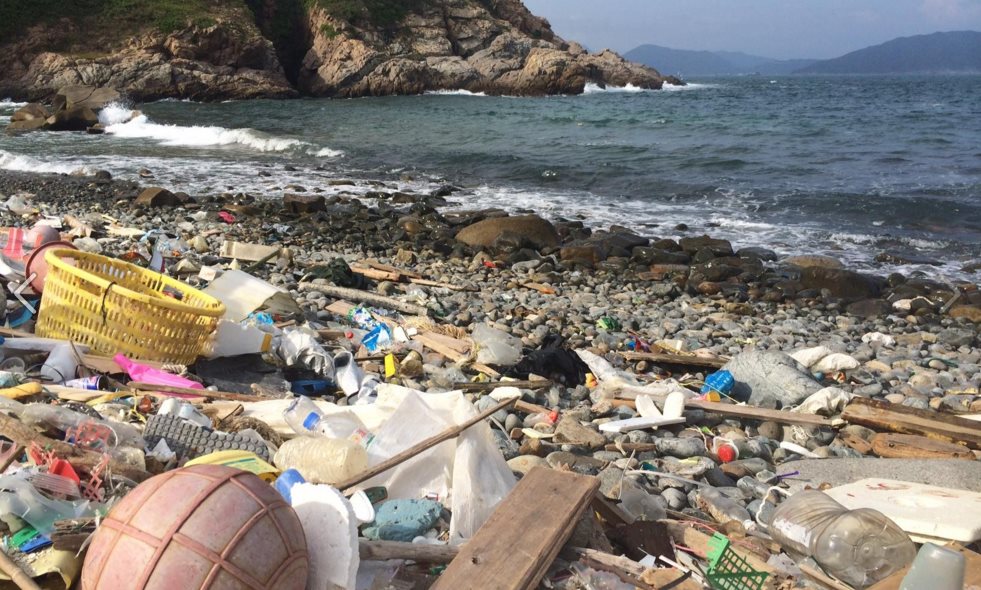Someone recently posted a photo of a strawberry online. It was a strawberry from one of our grocery stores in Hong Kong. While the price of the fruit was enough cause for comment in and of itself, the packaging was the stuff of nightmares. A lurid nest, it contained, non-exhaustively, laminated cardboard, a styrofoam shock absorber with a girth several times that of the berry it existed to protect, cling wrap, and something intended to look like hay, which I can only imagine was made of more plastic.

While humankind hasn’t been building its plastic legacy for very long, we are doing it with particularly alarming celerity. Unfortunately, plastic lives well beyond its use to us. It is estimated that plastic takes 500 years (or more) to break down. With reports of up to 2,000 tonnes of plastic being discarded in Hong Kong everyday, suffocating under an avalanche of the stuff isn’t just the melodramatic concern of this writer. Where do we go from here?
On the consumer front, there are some admirable zero waste warriors out there who lead by example and share practical tips to change habits and reduce plastic packaging dependence. Buying less, taking your own bags and containers to grocery stores, carrying your own water bottle, choosing paper over plastic, cutting out over-packaged products, and buying in bulk are some simple but impactful actions to take. Thinking of your actual needs and planning purchases thoughtfully does help in avoiding the daily trap of feeling overwhelmed and bereft of choice in stores full of gleaming plastic.

On the corporate front, the challenges are manifold. For profit-making purposes, companies need to sell products that consumers will buy or can be persuaded to buy. Among a host of reasons, consumers will buy what looks appealing, is or appears to be safe to consume, offers convenience, fits their price points – both realistic and aspirational, addresses a real or perceived need, or plainly because it makes them feel good. Packaging reigns in a lot of these areas, often making or breaking sales. One-time use plastic containers create the illusion of hygiene compared to items without them, and prove to be convenient to carry. Bruised produce gets left behind, often because of how it looks in comparison to its pristine, asphyxiated kin encased in plastic. Plastic has proved to be the way to sell more, cheaply, alluringly, and quickly.
Some companies are exploring better options to continue their businesses but reduce their negative impact. Reducing the amount of plastic in packaging, allowing consumers to choose what they actually need versus blanket provision of items like plastic cutlery, and using better and more sustainable materials can indeed go a long way. I’ve observed some interesting developments such as banana peels being turned into bioplastic, Ikea and Dell using and exploring mushroom-based packaging, “edible plastic” made from casein, and reducing the amount of plastic in bottles, all of which seem to offer viable, less harmful alternatives. The Ellen MacArthur Foundation envisions more business-driven alternatives to plastic packaging, which its recent report developed in conjunction with the World Economic Forum dives into. While these developments are certainly reasons for some optimism, none of this is happening fast enough or on a large enough scale to address the waste calamity, nor are they thorough solutions.

I acknowledge that plastic packaging is sometimes necessary, even crucial in some contexts. We live in cities, we don’t grow our own food or make our own shoes, we work too much to always cook our own meals, and we desire convenience and hygiene. But we simply have to do better.
Toxins leaching into water and food, the shocking impact of plastic waste on marine life, and the non-theoretical challenge of where our waste should go in the future given our burgeoning landfills, are just some of the acute repercussions of our habits and consumer culture. As consumers, we need to severely contain our profligacy, keep pushing for responsible products and packaging, and vote with our wallets. As producers and propagators, corporations need to take stock of what they’re pushing to market, actively listen to consumers, and choose to invest in less harmful packaging alternatives.
So let’s do better. Now put down that ludicrous strawberry.
